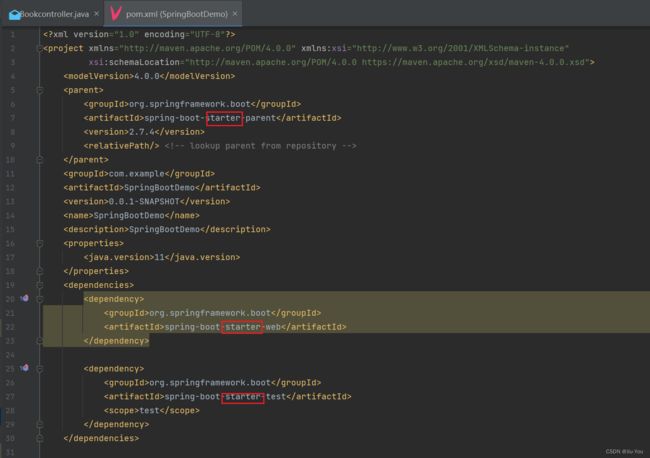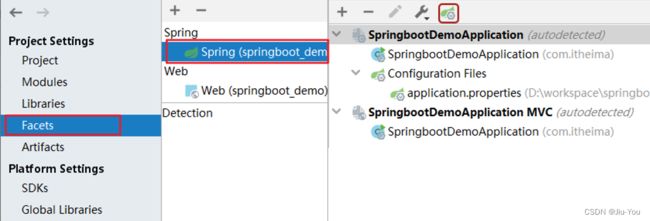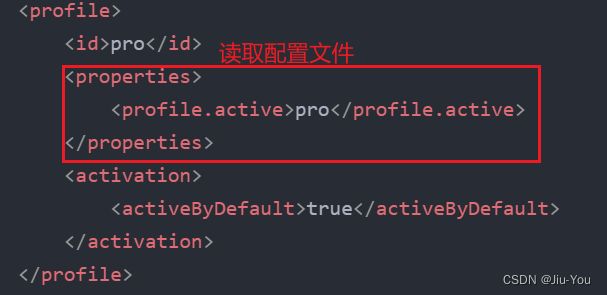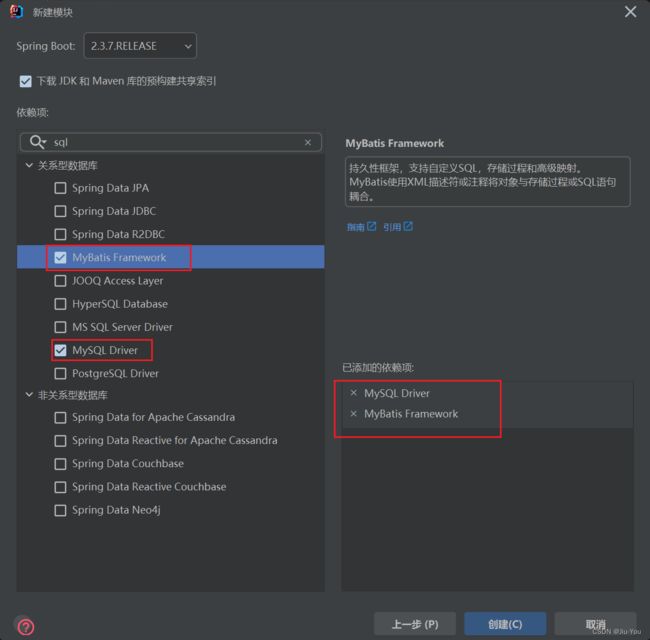黑马程序员SSM_SpringBoot笔记(自用)
SpringBoot_1_简介
1.入门案例
@RestController
@RequestMapping("/books")
public class BookController {
@GetMapping("/{id}")
public String getById(@PathVariable Integer id){
System.out.println("id ==> "+id);
return "hello , spring boot!";
}
}
- 启动服务器
运行SpringBoot工程不需要使用本地的Tomcat和 插件,只运行项目包下的Application类,我们就可以在控制台看出如下信息

- 使用
Postman工具来测试我们的程序 - 对比
做完SpringBoot的入门案例后,接下来对比一下Spring程序和SpringBoot程序。如下图

-
坐标
Spring程序中的坐标需要自己编写,而且坐标非常多SpringBoot程序中的坐标是我们在创建工程时进行勾选自动生成的 -
web3.0配置类
Spring程序需要自己编写这个配置类。这个配置类大家之前编写过,肯定感觉很复杂SpringBoot程序不需要我们自己书写 -
配置类
Spring/SpringMVC程序的配置类需要自己书写。而SpringBoot程序则不需要书写。
注意:基于Idea的
Spring Initializr快速构建SpringBoot工程时需要联网。
2.官网构建工程(不用idea构建工程)
- 进入springboot官网
3.SpringBoot工程快速启动
- 打包
由于我们在构建SpringBoot工程时已经在pom.xml中配置了如下插件
<plugin>
<groupId>org.springframework.bootgroupId>
<artifactId>spring-boot-maven-pluginartifactId>
plugin>
所以我们只需要使用 Maven 的 package 指令打包就会在 target 目录下生成对应的 Jar 包。

2. 启动
进入 jar 包所在位置,在 命令提示符 中输入如下命令
jar -jar springboot_01_quickstart-0.0.1-SNAPSHOT.jar
//输入jar -jar s再按tab键自动补全
执行上述命令就可以看到 SpringBoot 运行的日志信息

4.SpringBoot概述
SpringBoot 是由Pivotal团队提供的全新框架,其设计目的是用来简化Spring应用的初始搭建以及开发过程。
大家已经感受了 SpringBoot 程序,回过头看看 SpringBoot 主要作用是什么,就是简化 Spring 的搭建过程和开发过程。
原始 Spring 环境搭建和开发存在以下问题:
- 配置繁琐
- 依赖设置繁琐
SpringBoot 程序优点恰巧就是针对 Spring 的缺点
- 自动配置。这个是用来解决
Spring程序配置繁琐的问题 - 起步依赖。这个是用来解决
Spring程序依赖设置繁琐的问题 - 辅助功能(内置服务器,…)。我们在启动
SpringBoot程序时既没有使用本地的tomcat也没有使用tomcat插件,而是使用SpringBoot内置的服务器。
1.起步依赖
- 我们使用
Spring Initializr方式创建的Maven工程的的pom.xml配置文件中自动生成了很多包含starter的依赖,如下图

- 这些就是启动依赖,它定义了当前项目使用的所有项目坐标,以达到减少依赖配置的目的
- parent:所有
SpringBoot项目要继承的项目,定义了若干个坐标版本号(依赖管理,而非依赖),以达到减少依赖冲突的目的
2.程序启动
- 创建的每一个
SpringBoot程序时都包含一个类似于下面的类,我们将这个类称作引导类
@SpringBootApplication
public class Springboot01QuickstartApplication {
public static void main(String[] args) {
SpringApplication.run(Springboot01QuickstartApplication.class, args);
}
}
注意:
-
SpringBoot在创建项目时,采用jar的打包方式 -
SpringBoot的引导类是项目的入口,运行main方法就可以启动项目因为我们在
pom.xml中配置了spring-boot-starter-web依赖,而该依赖通过前面的学习知道它依赖tomcat,所以运行main方法就可以使用tomcat启动咱们的工程。3.切换web服务器
- 现在我们启动工程使用的是
tomcat服务器,那能不能不使用tomcat而使用jetty服务器,jetty在我们maven高级时讲maven私服使用的服务器。而要切换web服务器就需要将默认的tomcat服务器给排除掉,怎么排除呢?使用exclusion标签
- 现在我们启动工程使用的是
<dependency>
<groupId>org.springframework.bootgroupId>
<artifactId>spring-boot-starter-webartifactId>
<exclusions>
<exclusion>
<artifactId>spring-boot-starter-tomcatartifactId>
<groupId>org.springframework.bootgroupId>
exclusion>
exclusions>
dependency>
- 引入
jetty服务器。在pom.xml中因为jetty的起步依赖
<dependency>
<groupId>org.springframework.bootgroupId>
<artifactId>spring-boot-starter-jettyartifactId>
dependency>
SpringBoot_2_配置文件
1.配置文件格式
- 我们现在启动服务器默认的端口号是
8080,但在线上环境我们还是希望将端口号改为80,这样在访问的时候就可以不写端口号了,修改方式如下:
http://localhost/books/1
- SpringBoot程序修改方式:
application.properties
server.port=80
application.yml
server:
port: 81
application.yaml
server:
port: 82
注意:SpringBoot 程序的配置文件名必须是 application ,只是后缀名不同而已
在开发过程中,配置文件中如果没有提示,可以使用以下方式
-
通过上述几步后,就可以看到如下界面。
properties类型的配合文件有一个,ymal类型的配置文件有两个 -
这三种配置的优先级为:
application.properties>application.yml>application.yaml
2.yaml格式
1.yaml格式优点
**YAML(YAML Ain’t Markup Language),一种数据序列化格式。**这种格式的配置文件在近些年已经占有主导地位,这种配置文件和前期使用的配置文件是有一些优势的.
优点:
-
容易阅读
yaml类型的配置文件比xml类型的配置文件更容易阅读,结构更加清晰 -
容易与脚本语言交互
-
以数据为核心,重数据轻格式
yaml更注重数据,而xml更注重格式
YAML 文件扩展名:
.yml(主流).yaml
上面两种后缀名都可以,以后使用更多的还是 yml 的。
2.yaml格式语法规则
-
大小写敏感
-
属性层级关系使用多行描述,每行结尾使用冒号结束
-
使用缩进表示层级关系,同层级左侧对齐,只允许使用空格(不允许使用Tab键)
空格的个数并不重要,只要保证同层级的左侧对齐即可。
-
属性值前面添加空格(属性名与属性值之间使用冒号+空格作为分隔)
-
# 表示注释
核心规则:数据前面要加空格与冒号隔开
3.yaml配置文件数据读取
1.使用 @Value注解
- 使用
@Value("表达式")注解可以从配合文件中读取数据,注解中用于读取属性名引用方式是:${一级属性名.二级属性名……} - 例如:我们可以在
BookController中使用@Value注解读取配合文件数据,如下
@RestController
@RequestMapping("/books")
public class BookController {
@Value("${lesson}")
private String lesson;
@Value("${server.port}")
private Integer port;
@Value("${enterprise.subject[0]}")
private String subject_00;
@GetMapping("/{id}")
public String getById(@PathVariable Integer id){
System.out.println(lesson);
System.out.println(port);
System.out.println(subject_00);
return "hello , spring boot!";
}
}
2.Environment对象
- 上面方式读取到的数据特别零散,
SpringBoot还可以使用@Autowired注解注入Environment对象的方式读取数据。这种方式SpringBoot会将配置文件中所有的数据封装到Environment对象中,如果需要使用哪个数据只需要通过调用Environment对象的getProperty(String name)方法获取。具体代码如下:
@RestController
@RequestMapping("/books")
public class BookController {
@Autowired
private Environment env;
@GetMapping("/{id}")
public String getById(@PathVariable Integer id){
System.out.println(env.getProperty("lesson"));
System.out.println(env.getProperty("enterprise.name"));
System.out.println(env.getProperty("enterprise.subject[0]"));
return "hello , spring boot!";
}
}
注意:这种方式,框架内容大量数据,而在开发中我们很少使用。
3.自定义对象
SpringBoot 还提供了将配置文件中的数据封装到我们自定义的实体类对象中的方式。具体操作如下:
-
将实体类
bean的创建交给Spring管理。在类上添加
@Component注解 -
使用
@ConfigurationProperties注解表示加载配置文件在该注解中也可以使用
prefix属性指定只加载指定前缀的数据 -
在
BookController中进行注入,具体代码如下:
//Enterprise内容如下:
@Component
@ConfigurationProperties(prefix = "enterprise")
public class Enterprise {
private String name;
private int age;
private String tel;
private String[] subject;
getter...
setter...
toString...
}
//BookController内容如下:
@RestController
@RequestMapping("/books")
public class BookController {
@Autowired
private Enterprise enterprise;
@GetMapping("/{id}")
public String getById(@PathVariable Integer id){
System.out.println(enterprise.getName());
System.out.println(enterprise.getAge());
System.out.println(enterprise.getSubject());
System.out.println(enterprise.getTel());
System.out.println(enterprise.getSubject()[0]);
return "hello , spring boot!";
}
}
注意:
使用第三种方式,在实体类上有如下警告提示

这个警告提示解决是在 pom.xml 中添加如下依赖即可
<dependency>
<groupId>org.springframework.bootgroupId>
<artifactId>spring-boot-configuration-processorartifactId>
<optional>trueoptional>
dependency>
4.多环境配置
1.yaml文件配置
在 application.yml 中使用 --- 来分割不同的配置,内容如下
#启用的配置
spring:
profiles:
active: dev #表示使用的是开发环境的配置
---
#开发
spring:
profiles: dev #给开发环境起的名字
server:
port: 80
---
#生产
spring:
profiles: pro #给生产环境起的名字
server:
port: 81
---
#测试
spring:
profiles: test #给测试环境起的名字
server:
port: 82
---
上述配置中的spring.profiles 配置项已经过时。最新用来起名字的配置项是
#开发
spring:
config:
activate:
on-profile: dev
2. properties文件
properties 类型的配置文件配置多环境需要定义不同的配置文件
application-dev.properties是开发环境的配置文件。我们在该文件中配置端口号为80
server.port=80
application-test.properties是测试环境的配置文件。我们在该文件中配置端口号为81
server.port=81
application-pro.properties是生产环境的配置文件。我们在该文件中配置端口号为82
server.port=82
3.多环境启动命令格式
1.方式
- 使用
SpringBoot开发的程序以后都是打成jar包,通过java -jar xxx.jar的方式启动服务的.而通过命令行有以下三种方式来指定环境:
SpringBoot提供了在运行jar时设置开启指定的环境的方式
java –jar xxx.jar –-spring.profiles.active=test
- 指定端口号
java –jar xxx.jar –-server.port=88
- 同时设置多个配置,比如即指定启用哪个环境配置,又临时指定端口
java –jar springboot.jar –-server.port=88 –-spring.profiles.active=test
2.在打包到指定环境启动容易遇见的坑
- 在执行package命令前执行一次clean命令,防止之前执行结果影响打包
- 文件编码问题可能导致打包失败,去setting->Editor->File Encoding将Project Encoding和Default encoding for properties files改为utf-8即可
4.多环境开发兼容问题(maven和boot兼容)
- Maven中设置多环境配置
<profiles>
<profile>
<id>devid>
<properties>
<profile.active>devprofile.active>
properties>
profile>
<profile>
<id>proid>
<properties>
<profile.active>proprofile.active>
properties>
<activation>
<activeByDefault>trueactiveByDefault>
activation>
profile>
<profile>
<id>testid>
<properties>
<profile.active>testprofile.active>
properties>
profile>
profiles>
- SpringBoot中也设置了多环境,要使他们兼容,得让配置文件读取maven配置的多环境
#设置启用的环境
spring:
profiles:
active: ${profile.active}
---
#开发
spring:
profiles: dev
server:
port: 80
---
#生产
spring:
profiles: pro
server:
port: 81
---
#测试
spring:
profiles: test
server:
port: 82
---
- 最终运行时配置文件中的
${profile.active}会被修改为pom文件中指定的pro了
- 因此我们要对于源码中非java类的操作要求加载Maven对应的属性,解析
${}占位符 - pom文件中添加插件
<plugin>
<groupId>org.apache.maven.pluginsgroupId>
<artifactId>maven-resources-pluginartifactId>
<version>3.2.0version>
<configuration>
<encoding>UTF-8encoding>
<useDefaultDelimiters>trueuseDefaultDelimiters>
configuration>
plugin>
5.配置文件分类
SpringBoot 定义了配置文件不同的放置的位置;而放在不同位置的优先级时不同的。
SpringBoot 中4级配置文件放置位置:
- 1级:classpath:application.yml
- 在
resources下创建的application.yml配置文件
- 在
- 2级:classpath:config/application.yml
- 在
resources下创建一个名为config的目录,在该目录中创建application.yml配置文件
- 在
- 3级:file :application.yml
- 在
jar包所在位置创建application.yml配置文件
- 在
- 4级:file :config/application.yml
- 在
jar包所在位置创建config文件夹,在该文件夹下创建application.yml配置文件
- 在
- 作用:
- 1级与2级留做系统打包后设置通用属性
- 3级和4级用于系统开发阶段设置通用属性
**说明:**级别越高优先级越高
SpringBoot_3_整合
1.SpringBoot整合junit
- 在
test/java下创建com.itheima包,在该包下创建测试类,将BookService注入到该测试类中
@SpringBootTest//第一步,加上该注解
class Springboot07TestApplicationTests {
@Autowired//第二步,将要测试的bean自动装配
private BookService bookService;
@Test//第三步,测试
public void save() {
bookService.save();
}
}
2.SpringBoot整合mybatis
@SpringBootTest
class Springboot08MybatisApplicationTests {
@Autowired
private BookDao bookDao;
@Test
void testGetById() {
Book book = bookDao.getById(1);
System.out.println(book);
}
}
- 设置数据源参数
spring:
datasource:
driver-class-name: com.mysql.jdbc.Driver
url: jdbc:mysql://localhost:3306/ssm_db?serverTimezone=UTC
username: root
password: root
- 给dao接口加上
@Mapper注解
Mybatis会扫描接口并创建接口的代码对象交给Spring管理,但是现在并没有告诉Mybatis哪个是dao接口。而我们要解决这个问题需要在Dao接口上使用@Mapper,例如
@Mapper
public interface BookDao {
@Select("select * from tbl_book where id = #{id}")
public Book getById(Integer id);
}
- 使用Druid数据源
- 导入
Druid依赖 - 在
application.yml配置文件配置
spring:
datasource:
driver-class-name: com.mysql.cj.jdbc.Driver
url: jdbc:mysql://localhost:3306/ssm_db?serverTimezone=UTC
username: root
password: root
type: com.alibaba.druid.pool.DruidDataSource











